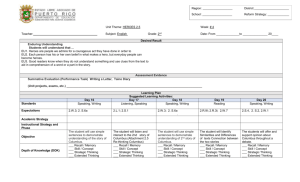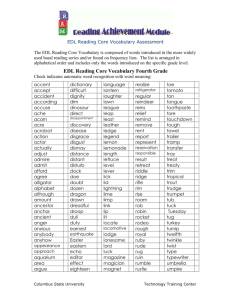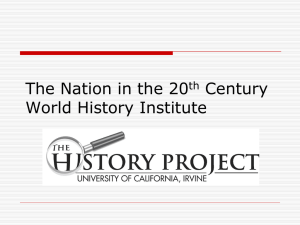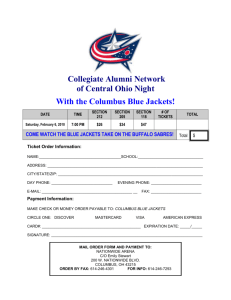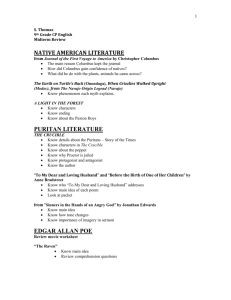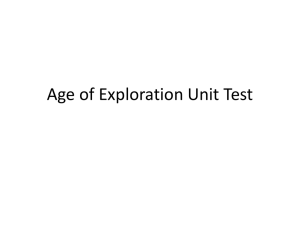Heroes and Holidays: How they can be part of Teaching for Social
advertisement
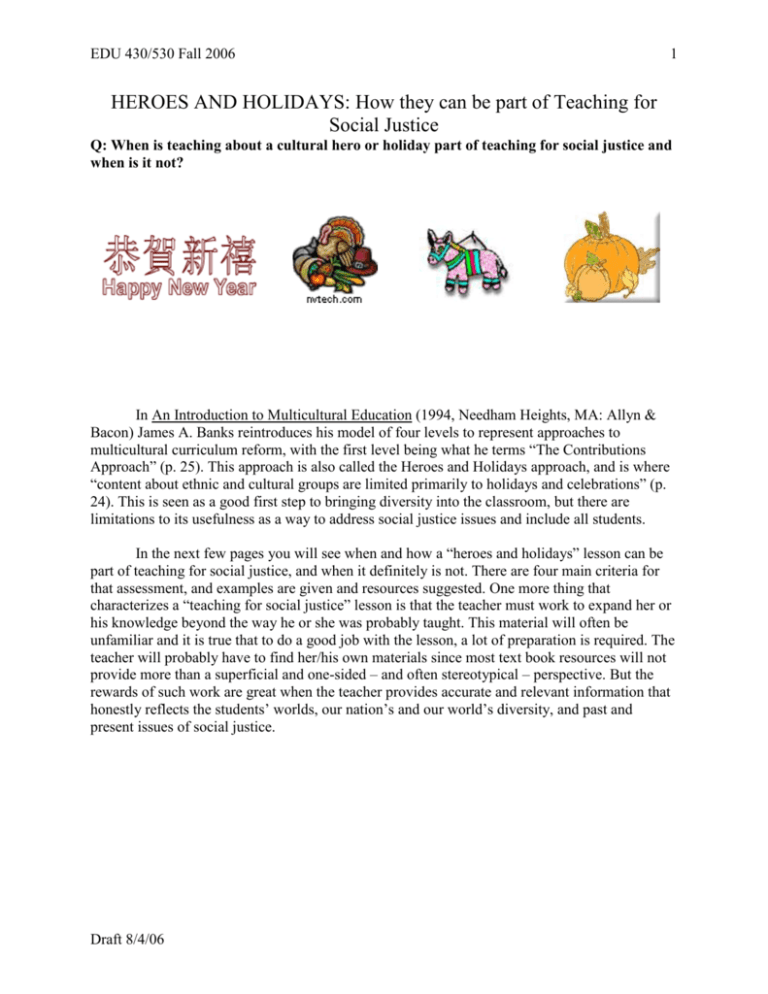
EDU 430/530 Fall 2006 1 HEROES AND HOLIDAYS: How they can be part of Teaching for Social Justice Q: When is teaching about a cultural hero or holiday part of teaching for social justice and when is it not? In An Introduction to Multicultural Education (1994, Needham Heights, MA: Allyn & Bacon) James A. Banks reintroduces his model of four levels to represent approaches to multicultural curriculum reform, with the first level being what he terms “The Contributions Approach” (p. 25). This approach is also called the Heroes and Holidays approach, and is where “content about ethnic and cultural groups are limited primarily to holidays and celebrations” (p. 24). This is seen as a good first step to bringing diversity into the classroom, but there are limitations to its usefulness as a way to address social justice issues and include all students. In the next few pages you will see when and how a “heroes and holidays” lesson can be part of teaching for social justice, and when it definitely is not. There are four main criteria for that assessment, and examples are given and resources suggested. One more thing that characterizes a “teaching for social justice” lesson is that the teacher must work to expand her or his knowledge beyond the way he or she was probably taught. This material will often be unfamiliar and it is true that to do a good job with the lesson, a lot of preparation is required. The teacher will probably have to find her/his own materials since most text book resources will not provide more than a superficial and one-sided – and often stereotypical – perspective. But the rewards of such work are great when the teacher provides accurate and relevant information that honestly reflects the students’ worlds, our nation’s and our world’s diversity, and past and present issues of social justice. Draft 8/4/06 EDU 430/530 Fall 2006 1. It would not be Teaching for Social Justice if YOU TRIVIALIZE, MARGINALIZE…. You stop your “regular” curriculum, to do a separate lesson on Rosa Parks, on Cesar Chávez, on Martin Luther King. This trivializes and marginalizes anything you are teaching, making the person a token of their culture/gender/ethnicity. Students know that this diversion it is not as important as the “regular” curriculum. For example: you teach a lesson on Martin Luther King where you celebrate what a kind person he was, and what a great civic dream he had for America, and mention the Civil Rights Acts that righted some of the wrongs. One lesson, then back to a eurocentric curriculum. For example: you have students research a number of heroes, from a list that might include a baseball player, a musician, and someone, like Cesár Chavez or MLK who worked to end social injustice. Such assignments often become mere superficial biographies, and equating working for social justice with renown as a baseball player is trivializing. 2 It would be Teaching for Social Justice if YOU CONNECT, VALIDATE… You connect a lesson on Martin Luther King to other parts of your curriculum, so that focusing in on this leader expands upon rather than diverts from your curriculum. For example: you teach a lesson where you are focussing on a(nother) leader who worked to end the kinds of oppression (racism, segregation, discrimination) that the students had encountered/learned about in ELA, History or other content areas. The context of the struggle for civil rights and social justice should be a familiar one after students have addressed such issues across the curriculum. You connect issues in the past to issues in the present, to contextualize in a way that is relevant to students’ lives. For example: you teach a lesson where students research people who have worked or are working to make a difference in society – who are heroes to their communities or in the wider society. You ask students to gather information with a focus on what the person worked/works to change and how their work impacted/impacts society. #1 RESOURCES: In the article “Teaching About Unsung Heroes: Encouraging students to appreciate those who fought for social justice” (Rethinking Our Classrooms: Teaching for Equity and Justice (2001) (Pp. 37-41), Bill Bigelow had his students research someone who “tried to make this a better place to live and also significantly affected society” (p. 39). He provides a long list of people, characterized by gender and cultural diversity, from which students could choose, or they could choose someone else who fit the criteria. The students were to find out as much as they could, and report about the events that caused the person “to be willing to take the risks they took” (p. 39), what they wanted to accomplish, what they did accomplish, what methods they used, and what in their life the student could particularly relate to (p. 39). Draft 8/4/06 EDU 430/530 Fall 2006 2. It would not be Teaching for Social Justice if YOU DECONTEXTUALIZE….. You decontextualize the hero or holiday, separating them from the larger social movement or historical place. Great leaders don’t make history all by themselves, they are always part of organizations, movements, communities. For example: you teach about Rosa Parks and show her as a brave tired woman who just didn’t want to give up her seat instead of showing that she was part of a political movement that rose in response to an historical time and place. For example: you teach about leaders of early women’s rights movements. You talk about Susan B. Anthony, Lucretia Mott, Elizabeth Cady Stanton, but only focus on the demand for the vote, with no context of the legal, familial and societal gender inequities, nor of analysis, then or now. 3 It would be Teaching for Social Justice if YOU CONTEXTUALIZE… You contextualize the hero or holiday within issues of social justice, struggles for rights by groups of people, resistance to oppression. For example: you talk about Rosa Parks’s political affiliations and the political ideologies of that movement. You see her bravery not as just a personal act but as coming out of community determination. You include the political and social context of the community’s struggle for social justice. RESOURCES: See 2A below For example: you examine the writing of American women’s rights leaders during the 1800’s and during the women’s movement during the late 1900’s. The students map out the issues, and also examine what are (still) issues today. RESOURCES: See #2B below #2A RESOURCES: The Teaching Tolerance website has many articles and lesson plans you can access through the links. http://www.tolerance.org/search/query.html?col=splctt&qt=Rosa+Parks Tolerance.org: Teaching Tolerance: LESSON PLANS: Rosa Parks' Foremothers September 26, 2005 -- Teaching Tolerance offers classroom activities in advance of December's 50th anniversary of the Montgomery Bus Boycott. Learn about ... Tolerance.org: Teaching Tolerance: BROWDER v. GAYLE: The Women Before Rosa Parks Learn about the legal battle that made the Montgomery Bus Boycott successful. Draft 8/4/06 EDU 430/530 Fall 2006 4 Tolerance.org: Teaching Tolerance: Mighty Times: The Legacy of Rosa Parks September 2002 -- Use these classroom activities and our curriculum kit to explore the Montgomery Bus Boycott of 1955. Tolerance.org: Teaching Tolerance: Before Rosa Parks: Middle Grades Activity Ida B. Wells Ida B. Wells is best known for her activism in the anti-lynching campaign. She moved to Chicago in her 20s and was a major figure in suffrage and ... #2B RESOURCES: Women's History Month: Women Making Change, Women Forging Hope http://www.tolerance.org/teach/activities/activity.jsp?p=0&ar=87&pa=4# This page includes links to a rich curriculum of women activists around the world. Topics include: Environmentalism; Human Rights; Rights of Indigenous Peoples; Rights of Children; Peace and Disarmament; Warfare and Its Aftermath And guidance as to how to use the materials: “The activism of many of the women arose out of complex, desperate situations. Understanding how political conflict developed within the context of a country's history is essential to understanding these women's actions. We have provided background information through the 'Timelines.' Although a 'Timeline' appears after the text, we suggest that you read through the 'Timeline' first, and refer back to it as you read the text. Also following each text are 'Things to Do and Discuss,' activities and questions for students to discuss or write about. Each section also contains a 'Selected Bibliography' and 'Other Resources,' including organizations, Internet Websites, and videos. At the end of the book are 'Ways to use the Posters and Biographies' as well as 'General Resources' and a world map. We hope that this material will facilitate use of the posters and Study Guide in a wide range of classroom situations, and that study of the International Women of Hope will lead to a greater understanding of today's global problems and the ways women are working to help solve them.” Also: A great resource for materials about the Women’s Movements in this country: The National Women's History Project is an educational nonprofit organization whose mission “is to recognize and celebrate the diverse and historic accomplishments of women by providing information and educational materials and programs.” http://www.nwhp.org/about_nwhp/mission/mission.html Draft 8/4/06 EDU 430/530 Fall 2006 3. It would not be Teaching for Social Justice if YOU HAVE LIMITED AND/OR INACCURATE INFORMATION…. you have little information, or inaccurate information, or you have information only from a eurocentric perspective, or you misrepresent someone/something historically. For example: you are doing a lesson on Cinco de Mayo without including the history around it – why it is important to Mexican people – especially those who live in the United States. Sometimes teachers present it as an Independence Day celebration, which it isn’t (September 16 is Mexican Independence Day). For example: you are teaching about Columbus and Columbus Day, but don’t include the Taino perspective or only present Columbus as the great explorer for Europe. For example: you are teaching about Thanksgiving, and teach that the holiday annually – and continuously celebrates the First Thanksgiving between the Pilgrims and the Native Americans. This is misinformation and leads to a sugar-coated version of history. 5 It would be teaching for Social Justice if YOU FIND ACCURATE AND SUFFICIENT INFORMATION… You have information for the students to use, and also have enough background information to supplement lessons. For example: you could examine Independence days, events that represented a defense of sovereignty (ex Cinco de Mayo), revolutions in many countries… a great opportunity to look at issues of perspective – why do we call one revolutionary group defending their territory, “rebels,” and another, “freedom fighters?” You use current events. For example: you start the lesson by talking about the more than one million people living in the Caribbean when Columbus arrived, and you look at what happened to them, maybe using the testimony of the Spanish Priest De Las Casas who was an advocate for them. You look at the events from both perspectives - that of the indigenous people already there, and that of Columbus and the interests he represented. You show how these events still resonate today. RESOURCES: See #3A below For example: you are teaching about Thanksgiving, and find some historical accounts of a first recorded dinner with the Native peoples, and also some history of the holiday into modern times. You also can talk about celebrations of harvest thanksgiving that were/are practiced in Europe and in many Native American communities. RESOURCES: See #3B below #3A RESOURCES: The book Rethinking Columbus: The Next 500 Years (1998), is edited by Bill Bigelow & Bob Peterson and published by Rethinking Schools, Milwaukee, Wisconsin. It contains lots of ideas and lessons about Columbus, the Tainos, other Native-White encounters in the Americas, and issues past and present. Draft 8/4/06 EDU 430/530 Fall 2006 6 #3B RESOURCES: “A Native Perspective on Thanksgiving” which is “adapted from The Wabanakis of Maine and the Maritimes: A resource Book About Penobscot, Passamaquoddy, Maliseet, Micmac and Abenaki Indians (1989), prepared for and published by the Maine Indian Program, American Friends Service Committee. This is an excellent curriculum guide which includes lesson plans for grades 4-8.” (Lee, E., Menkart, D., & Okazawa-Rey, M. (eds) (1998). Beyond Heroes and Holidays. Washington, DC: Network of Educators on the Americas. (pp. 381-382). This lesson includes a handout using material from Unlearning Indian Stereotypes, (1977), Council on Interracial Books for Children. The lesson gives students much accurate information on the historical and cultural event, from the Native perspective. It raises issues for discussion, connecting to the present and the students’ experiences. Draft 8/4/06 EDU 430/530 Fall 2006 4. YOU AVOID CONTROVERSIAL/AMBIGUOUS TOPICS AND/OR SUGAR COAT THE MATERIAL… You avoid controversial issues, ambiguities, and unresolved issues, and sugar coat political or social realities. For example: you are teaching about Columbus Day, and avoid talking about the destruction of the Taino people, avoid exploring the debate about the ethics of killing/converting the Taino, which was raging at the time. For example: you are teaching about Native American leaders such as Geronimo or Chief Joseph, focusing positively on their leadership qualities, without addressing the ongoing conflicts with the euro-Americans that prompted their leadership roles. Conflicts that were not resolved and still exist today (land, culture, language). 7 YOU ADDRESS CONTROVERSIAL/AMBIGUOUS TOPICS AND DON’T SUGAR-COAT THE MATERIAL… You deal with controversial, ambiguous, and unresolved issues For example: you tell the truth about what happened when Columbus encountered/conquered the Taino people. You present the information (there are primary sources) and show students the ambiguities, the messiness of history! You tell the stories from multiple perspectives – Taino, Columbus, De Las Casas. For example: You teach about these Native American leaders within the context of the issues with the US government at the time. You present both perspectives and look at the nature of the conflicts – physical, philosophical, cultural. You look at what issues are still unresolved today. RESOURCES: see #4 below #4 RESOURCES: A web site that looks at Great Native American Leaders & Patriots: http://members.tripod.com/~RFester/chiefs.html The web page prefaces its annotated list of Native American leaders: When elementary and high school students are taught American history, it usually begins with Christobel Columbus and the Nina, Pinta,and Santa Maria discovering the New World. Never mind that the Americas already were inhabited by highly advanced civilizations. With the arrival of Columbus, official history begins. It should come as no surprise that great Native American leaders are for the most part ignored in history classes rooted in the old Columbus myths. In fact, it is debatable that he was even the first European to arrive in the Americas. But that is a different story. The few Native American exceptions to make the history books were the "friends of the whites"--Pochahontas, Squanto, etc--or "vicious savages"-Pontiac, Crazy Horse. This site seeks to honor great Native American leaders and patriots and inasmuch as is possible, present them as they were rather than as the institutional powers-that-be consider them to have been. Also: A site called KidInfo, that is a history search engine has many links to many Native American leaders: http://www.kidinfo.com/American_History/Native_Americans.html Draft 8/4/06

